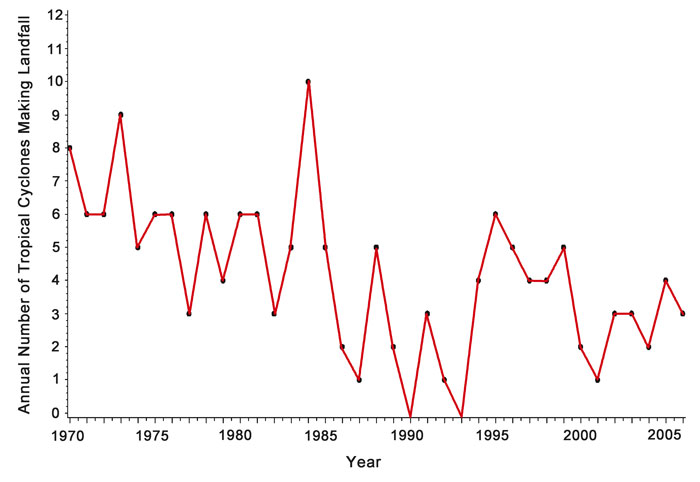| Tweet | Follow @co2science |
Paper Reviewed
Seo, S.N. 2014. Estimating tropical cyclone damages under climate change in the Southern Hemisphere using reported damages. Environmental and Resource Economics 58: 473-490.
Hurricanes, or tropical cyclones as they are known by those living outside the USA, represent one of the most devastating and destructive forces of nature. Given the amount of damage they can inflict on both society and the natural world, it is no wonder that these atmospheric phenomena frequently serve as poster children for the global warming movement - think Hurricane Andrew, Katrina, or Sandy. Whenever and wherever they occur, rest assured, you can count on some climate alarmist weighing in with a statement to the media that that storm was caused, or made worse, by global warming.
Indeed, it is a long held position of climate alarmists that CO2-induced global warming will cause more frequent and/or more severe tropical cyclones in the future, resulting in escalating economic damages. But are such claims true? In one of the latest scientific studies to address this topic, Dr. S. Niggol Seo, faculty member at the University of Sidney, examined trends in tropical cyclones impacting Australia in a paper published in the academic journal Environmental and Resource Economics.
Writing as background for his work, Seo states that alarming predictions of more intense hurricanes due to climate change "are of great concern," yet he says there have been "few TC [tropical cyclone] studies in the Southern Hemisphere," adding that there has been "no economic assessment of damages in the past," for which lack of attention he proceeds to make amends. More specifically, based on detailed reports of TCs that were generated in the Southern Ocean and hit the coasts of Australia since 1970, as compiled by that country's Bureau of Meteorology, Seo constructed damage estimates "using the reported financial loss, destruction of houses and capital goods, and losses of agricultural crops and livestock after a careful examination of the detailed individual cyclone reports," which also included "local area income and population density where the storm hit."
Seo's decision to examine the tropical cyclone data back to 1970 is important, because over that time (1970-2006) the CO2 concentration of the atmosphere rose by 55 parts per million (ppm), which rise amounts to more than half of global CO2 increase experienced since the dawn of the Industrial Revolution. In addition, global temperatures over this 36-year period rose by approximately 0.5°C to levels that climate alarmists consider to be unprecedented over the past two thousand years. Thus, if there exists a period of time in which one should be able to find a CO2/temperature-induced signal in the tropical cyclone record, the years examined by Seo would seem to be it. From a climate alarmist perspective, one could not have selected a better period to analyze!
Despite this alignment of the stars, so to speak, Seo's work fails to support claims that global warming is causing or will cause more frequent and severe tropical cyclones.
As illustrated in the figure below, perhaps the greatest failure comes from the Australian researcher's discovery that "TC frequency has significantly declined over time." Or, perhaps it is the equally damning finding that "there is no significant trend over the intensity of the TCs during that time." Beyond these realities, with respect to the financial damages, Seo reports that the "average damage per TC has significantly fallen over time since 1970 from 38 million AUD [Australian Dollars] per TC in the 1970s, to 11 million AUD in the 1980s and the 1990s, and to 1 million AUD in the first half of the 2000s."

Figure 1. Annual frequency of tropical cyclones, or hurricanes, making landfall in Australia over the period 1970-2006. Adapted from Seo, 2014.
The dramatic "decrease in the damage from TCs observed at the end of the twentieth century," according to Seo, "can be attributed in part to adaptation measures such as development planning, building codes, more accurate TC tracking and forecasts, early warning systems, and full preparedness and evacuations." But, of course, it must also be acknowledged that the significant decline in TC frequency that was found to have occurred over the course of the study period must also have played a prominent role.
Whatever the case, one conclusion from this study is certain, the unprecedented increase in the twin evils of the radical environmentalist movement (rising temperature and CO2) has not led to more frequent or more severe tropical cyclones hitting Australia in recent decades. There may well be a temperature/CO2 signal; it's just not the signal climate alarmists have long been claiming.
Posted 27 October 2014



